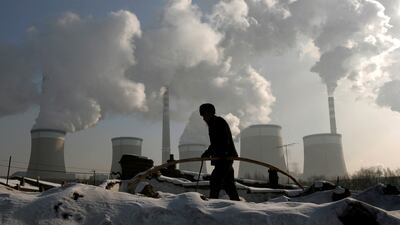A German military strategist would call it a "schwerpunkt" – the centre of gravity or the critical focal point. More people – some four billion – live inside a 3,300-kilometre radius circle centred on the small town of Mong Khet in Myanmar, than live outside it. This is the decisive area for the 21st century’s energy and climate geography.
This circle contains the first, second, fourth and fifth most populous countries in the world, namely India, China, Indonesia and Pakistan. From a geopolitical perspective, it contains a majority of adherents of three great world religions – Islam, Hinduism and Buddhism – as well as the secular philosophy of communism.
From a climate point of view, it produces more than half of global energy-related carbon dioxide emissions. It also accounts for 45 per cent of the world’s primary energy demand and 57 per cent of solar power capacity.
But with just 7 per cent of global oil production and 13 per cent of gas output, it is always destined to be a major fossil fuel importer.
The circle also hosts geopolitical flashpoints: the Korean peninsula, the competing claims of the littoral states to the South China Sea, Taiwan, regarded by Beijing as a breakaway province, the disputed Sino-Indian border, the important Strait of Malacca, and the perennially tense India-Pakistan relationship.
And within this is the majority of the world’s manufacturing capacity for clean energy technologies – solar panels, wind turbines, batteries and electric vehicles – mostly in China, but in the near future India, too.
There is also an increasing share of energy innovation, again in China but also in Japan and Taiwan. China dominates the mining and processing of rare earths, while Indonesia and, secondarily, the Philippines produce more than half the world’s nickel, crucial materials for electric motors, wind turbines and batteries.
It is no exaggeration to say that a liveable global climate, a stable energy market, depend much more on what happens within this circle over the next 70-odd years than on Washington, Brussels, Moscow or even the Gulf.
The GCC is well aware. Proximity to India makes it impossible to ignore: Prime Minister Narendra Modi has just concluded his visit to the UAE and Qatar. Asia is the main destination for the Middle East’s oil and gas exports, and Saudi Aramco has invested heavily to boost its refining and petrochemical capacity in China and Malaysia.
In contrast, the West has not yet woken up to this reality. Of course, there are honourable exceptions. The International Energy Agency plans to start membership talks with India; it also has associate agreements with China, Indonesia, Thailand and Singapore.
The Finland-based Centre for Research on Energy and Clean Air provides invaluable insights into Chinese environmental policy.
But mainstream climate and energy opinion focuses far too much on developments in the US and Western Europe.
It seems to think that the goal of limiting global warming can be achieved solely by demonising oil and gas companies, imposing ever tougher emissions targets on Europe, and opposing more fossil-fuel production and transport projects. Such a lack of perspective ignores Asian needs, realities and opinions.
Many Asian countries suffer from terrible air quality, mostly because of pollution from coal burning and traffic, causing serious health problems. China has made significant progress in recent years in switching district heating systems and industry to gas.
India, so far, has not, and it now has one of the worst urban air quality globally. Simplistic and skewed calculations that claim gas is “worse for the climate” than coal because of methane leakage entirely ignores other pollutants.
Because of a relative lack of fossil-fuel resources – particularly oil and gas – versus consumption, Asian countries are acutely aware of their need for energy security. Japan and Taiwan are virtual island economies, while South Korea is a landlocked peninsula. All three are particularly vulnerable to any interruption.
They see the value of renewables and nuclear power in providing domestic self-sufficiency, but they also value long-term relations with reliable oil and gas providers.
For China, India and Indonesia, the situation is a bit different. They have abundant cheap domestic coal, which also has strong domestic political and business constituencies. The giant scale of their energy needs, and its rapid growth, mean that they need all forms of energy for now.
Gas will have to be cheap, and renewables will have to overcome problems of financing, project siting and grid access to make inroads into coal use.
For all of them, if they cannot obtain oil and natural gas from the US, Australia or from African projects backed by western funding, they will get it from the Middle East, Russia and Central Asia.
Asian countries will indeed suffer badly from climate change – it is one of the major factors that could prevent the 21st century from being the fabled “Chinese Century” or “Indian Century”.
They still maintain they have limited historic responsibility for emissions, a contention that is increasingly not true in the case of China. But western hectoring will not be constructive.
A more constructive approach will work on common interests. It will be pragmatic, recognising that partial progress on reducing emissions is better than a fruitless pursuit of perfection.
It will concentrate on supplying greater quantities of cleaner, cheaper and more reliable energy, rather than restricting availability of disfavoured options. It will seek to combine disparate strengths in innovation, manufacturing, financing and project management to rapidly scale up low-carbon systems.
At a time of growing global conflict and tension, energy is a lever against rivals, while climate remains a rare bright spot of international co-operation. Solving the 21st century’s environmental and energy challenges centres on that Asian circle.
Robin M. Mills is chief executive of Qamar Energy and author of 'The Myth of the Oil Crisis'


